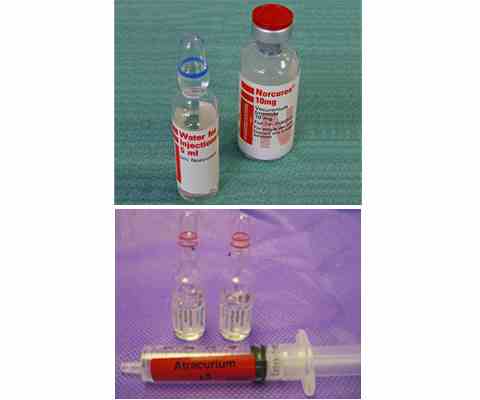Non-depolarizing Agents
The non-depolarizing NMBs are all competitive antagonists of acetylcholine at the neuromuscular junction.
They are classified according to their structure. There are two groups:
- Aminosteroids, e.g. Vecuronium
- Benzylisoquinoliniums, e.g. Atracurium
In most cases, the choice of non-depolarizing blocker is the personal preference of an individual anaesthetist, although atracurium is often avoided in asthmatic patients. Atracurium is often the agent of choice in the presence of renal or hepatic failure.
The effects of both agents may be potentiated by acidosis, high-dose gentamicin and magnesium therapy. The duration of blockade produced by vecuronium in particular is shortened in the presence of phenytoin and carbamezepine.
Always use a peripheral nerve stimulator to check their effects.

Vecuronium
Vecuronium requires mixing prior to use. Mixing with sterile water produces a clear, colourless solution.
It is a relatively clean drug having no effect on the cardiovascular or respiratory systems, apart from apnoea. The effects of other agents used at induction may be more pronounced, e.g. bradycardia following fentanyl.
It is metabolized in the liver and excreted in the bile and urine. Its effects may be prolonged with hepatic and renal dysfunction. Patients with induced liver enzymes, e.g. due to carbamazepine therapy, have a higher dose requirement.
Atracurium
Atracurium is broken down in two distinct ways:
- Hofmann degradation is unique to atracurium and involves spontaneous breakdown to laudanosine and an acrylate, which are inactive in humans. This degradation is temperature dependent, hence, atracurium must be stored in a fridge. If the storage temperature is suboptimal it may lose efficacy. In the body this breakdown is independent of enzyme systems, so atracurium can be eliminated by an organ-independent mechanism, which is an advantage in patients with renal or hepatic failure
- Ester hydrolysis is caused by non-specific esterases, which are distinct from plasma cholinesterase
Atracurium commonly causes local histamine release, with redness or a wheal-and-flare reaction. Occasionally there is systemic histamine release, which may precipitate small airway obstruction and wheeze, especially in asthmatics and when a large dose is given quickly. It may also cause vasodilation and hypotension